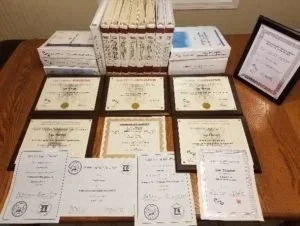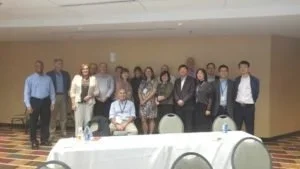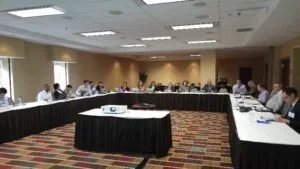An Engineer’s Journey into Configuration Management: The Importance of Training and Certification
In this month’s CMsights post we invited Lisa Fenwick, Vice President of CMstat, to share how configuration management training and configuration management certification became so important to her engineering career. Lisa writes…
I was very lucky when I graduated college with my BSME. My first job was performing project management for a government contractor. A dream job for someone fresh out of school and I was eager to get going. One day the urgent topic was fluid dynamics, the next day was hardware design, and the following day involved mechanics of materials. I loved the variety and felt competent, especially when the challenge de jour required understanding of the core engineering disciplines I learned in the classroom.
What I quickly discovered was that my engineering degree did not give me the skills to actually document, communicate, and manage the evolution of an engineering design from inception to customer use. As example, my engineering change proposals were frequently rejected because the tools required to perform the retrofit which I had specified were simply not available to those who would make the modification. I learned this the hard but memorable way while on-the-job.
So what major discipline was my college curriculum missing? Configuration management, a subject never mentioned in the engineering education of the time.
At work I was ever so fortunate to have found a generous mentor in CM who would give me all the direction I needed, especially if I approached her at the beginning of my design project, instead of at the end or when in crisis mode. She taught me CM from the middle outwards as she helped guide my design choices based on configuration control and logistics information. She freely shared her deep institutional history of the product along with a customized CM database tool that, oddly, was not available to us in engineering.
I eventually acquired all of the imperfect-fitting jigsaw pieces of the design process for a single product but still had little understanding of how to manage a complete product family, including all the manufactured variants and customer retrofits throughout the product’s lifecycle. Yet, the hard and soft skills of how to communicate changes and track configuration control over a widely dispersed organization that did not report to me remained a challenge.
My first formal exposure to CM as a discipline all of its own was to attend a class and become CMII Certified from the Institute of Configuration Management (now the Institute for Process Excellence). The configuration management certification process consisted of attending three classes, over three separate weeks spanning a cold winter. During my training I learned what effective documentation should look like for the recipient, not just the author; how the approval and release processes should be conducted; how to accommodate manufacturing requirements; how to prepare for the inevitable changes to a design long after it left engineering; how to account for and track change implementation; and many other best practices that I would not have to learn the hard way with OJT.
This classroom training made my professional work much easier for me and my reputation as being more dependable for my boss. I couldn’t count all the times during those three weeks that I thought to myself “ahhh, so that’s why we do this” along with a few “ohhh, that’s how I should have done that.” Having that larger picture has always been important to me as it is for most engineers who are naturally curious without much incitement. Knowing the “why” behind it was necessary for me to include someone on a change control board, beyond wanting her opinion or good will, was invaluable.
As my career progressed after joining CMstat, understanding and navigating the different, often conflicting priorities of project management, engineering services, quality assurance, supply chain procurement, and other functions became essential. Our CMstat customers began to expand their view of CM beyond that of an engineering department skill to a more strategic enterprise-wide competency. During this time CMstat’s PDMPlus CM software matured as a best-in-class COTS solution that found favor with program managers who needed to quickly stand up a nimble commercial-off-the-shelf CM solution.
When CMstat’s product suite grew beyond CM with Deliverables Data Management solutions, more training was required, specifically in the SAE EIA-859 standard for enterprise data management. I enthusiastically attended numerous courses from CMPIC and CMII to expand my knowledge base. Regular attendance at industry conferences like CM Trends, CMII, GEIA, ACDM, and CIMdata was invaluable. I owe much gratitude to the countless instructors, presenters, customers, authors, and colleagues across the CM spectrum whom I have met over the years at these events.
There are things one learns in engineering school and takes into the workplace. There are many more skills one acquires on-the-job that are necessary to actually perform the job efficiently. Yet, there is so much more to be gained from continuing education, industry associations, standards organizations, and from other practicing CM, DM, and Engineering professionals. Contribution to or participation in standards governing bodies like the SAE G-33 Committee for CM is just one example.
My configuration management training has not stopped since earning CMPIC’s Masters Certification in CM as well as the CMSME designation and CMII-C certification. The knowledge attained from earning these configuration management certifications is far more valuable to me than my sizable stash of engineering books or framed diplomas on my walls. They serve as the foundation of trust between my employer and customers, as well as between myself as head of product development and our engineering team. As one of my instructors is so fond of saying, certifications enable us to begin to learn in earnest.
Receive CMsights
Subscribe to CMsights News for the latest updates from CMstat on Configuration Management, Data Management, EPOCH CM, and EPOCH DM.
Request a Demo
See how EPOCH CM and EPOCH DM support industry standards and best practices in Configuration Management and Data Management.




